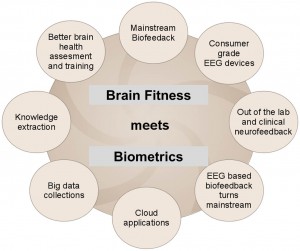Brain fitness meets HRV and EEG biometrics and neuroinformatics
 As an active participant in the OpenViBE project (a software platform to design, test and use Brain-Computer Interfaces), in scientific as well as technical capacities, I have long been focused on ways to process, analyze and put brain signals to practical use. When I started reading on the subject of brain fitness a few years ago, I recognized the potential to enhance a variety of brain training approaches, from meditation to cognitive training, by deploying devices measuring brain activity during training, and for the biometrics, neurofeedback and brain fitness communities to connect and work with each other. What I heard during the 2012 SharpBrains Summit: Optimizing Health Through Neuroplasticity, Innovation and Data demonstrated that things are indeed moving in the right direction.
As an active participant in the OpenViBE project (a software platform to design, test and use Brain-Computer Interfaces), in scientific as well as technical capacities, I have long been focused on ways to process, analyze and put brain signals to practical use. When I started reading on the subject of brain fitness a few years ago, I recognized the potential to enhance a variety of brain training approaches, from meditation to cognitive training, by deploying devices measuring brain activity during training, and for the biometrics, neurofeedback and brain fitness communities to connect and work with each other. What I heard during the 2012 SharpBrains Summit: Optimizing Health Through Neuroplasticity, Innovation and Data demonstrated that things are indeed moving in the right direction.
We are witnessing a “super convergence” taking place:
1. Biofeedback (particularly Heart Rate Variability) is now mainstream. Heart Rate Variability (HRV) was mentioned a dozen of times as appropriate biofeedback medium for relaxation and emotional regulation. SharpBrains is now putting it at step 8 of their “How To Be Your Own Brain Fitness Coach” elearning course. HRV is measured with Electro-cardiography (ECG), which is now mainstream through the availability of phone-connected ECG devices, designed, for instance, for casual athletes. Among other examples, Savannah DeVarney, VP Products at Brain Resource, introduced MyCalmBeat, a stress management mobile application targeting companies and their employees to help decrease stress, sharpen focus and improve health in systematic ways.
2. Cheaper electro-encephalography (EEG) devices are consumer-friendly for the first time, and suitable for use out-of-the-lab and out-of-the-clinic. Stanley Yang, CEO of Neurosky, and Tan Le, CEO of Emotiv Lifesciences, presented their respective consumer-grade EEG platforms for home or office use, which do not require the help of an expert for set-up. Their technology was first marketed with video games in mind (Emotiv sold devices in 90 countries, and Neurosky sold more than 1M chips already), but both companies are now looking forward to mainstream brain health and wellness applications. Inexpensive multi-sensor devices such as the Emotiv EPOC can record real brain signals, and have been used by Brain Computer Interfaces (BCI) research labs for several years now. The availability of this technology at low prices opens up opportunities of using EEG out of the lab or of the hospital, as for instance at home or office.
3. Valuable information can be extracted from EEG (and Quantitative EEG) to enable next-generation brain health assessments. Dr Evian Gordon outlined that EEG is becoming really scalable, mostly because of the emergence of ultra-cheap devices, predicting that these technologies are less than 10 years from what we have today for heart monitoring. Dr. Adam Gazzaley, Director of the Neuroscience Imaging Center of the UCSF, discussed the work his lab is already doing in that direction. Data points like these demonstrate that EEG-based biometrics can add value to traditional brain health assessments, which often rely on symptoms or tie-consuming neuropsychological batteries. For instance, some specific markers (such as the decreased latency and amplitudes of P300 Evoked Response Potentials) antedates and could help predict Alzheimer’s Disease symptoms 10 to 15 years in advance.
4. Neuroinformatics will drive massive change — not just in brain health care, but in healthcare overall. Our knowledge of brain functions is being greatly expanded through the large-scale collection and storage of brain signals in massive databases, and data analysis is delivering an increasingly deeper understanding of how our brain, cognition and behavior are interrelated, and how to personalize interventions based on objective markers. Collecting and segmenting big volumes of data to build relevant profiles and knowledge was thus a major concern of many speakers, with one of the summit sessions focused on this particular topic. Dr. Robert Bilder, Chief of Medical Psychology at UCLA Semel Institute for Neuroscience, talked about the considerable amount of data that they are collecting from as much biodata sensors as possible on patients and users. Dr Gordon stressed the need to standardize data collection and analysis, and Dr. Sandra Chapman at UT-Dallas reinforced the critical point that “there is no health without brain health.” Collecting big amount of data is becoming easier to setup thanks to cloud-based applications.
All in all, the extensive conversations at the 2012 SharpBrains Virtual Summit, and the converging work of the many industry and scientific pioneers who participated, highlighted the need and the very realistic opportunity to monitor and analyze brain activity in scalable and cost-efficient ways, and to personalize brain health prevention and interventions based on objective data. Or, as the Summit tagline promised, to Optimize Health through Neuroplasticity, Innovation and Data.
 - Yann Renard is is CTO and co-founder of Mensia Technologies. He led OpenViBE software development at INRIA for 5 years and is now developing an online platform for realtime brain signal processing, visualisation and training at Mensia Technologies.
- Yann Renard is is CTO and co-founder of Mensia Technologies. He led OpenViBE software development at INRIA for 5 years and is now developing an online platform for realtime brain signal processing, visualisation and training at Mensia Technologies.


